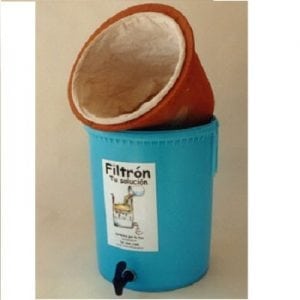
Agriculture
November 9, 2023
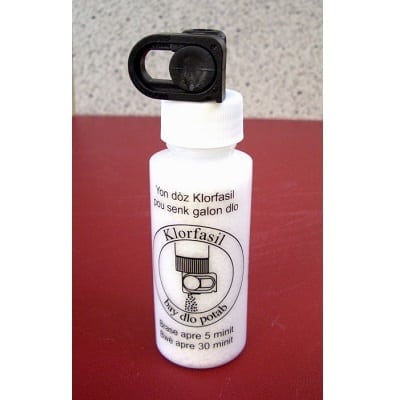
Updated on November 9, 2023
·Created on August 27, 2015
Klorfasil is a locally produced granulated chlorine solution for treating water.
Klorfasil is a locally produced chlorination product for drinking water treatment in rural Haiti. This NGO (also named Klorfasil) sells granulated chlorine, sodium dichloroisocyanurate dihydrate (NaDCC), for disinfection. Klorfasil is intended for household use to reduce transmission of water-borne disease and incidences of diarrhoea.
Target Countries
Haiti
Target SDGs
SDG 6: Clean Water and Sanitation
Market Suggested Retail Price
$9.96
Target Users (Target Impact Group)
Household
Distributors / Implementing Organizations
Klorfasil
Competitive Landscape
Direct competitors include Gadyen Dlo.
Manufacturing/Building Method
Klorfasil dispensers are assembled by hand in Haiti.Interview with representative
Intellectural Property Type
Other
User Provision Model
Donations are generally distributed by Klorfasil in sponsorship or association with some other organisations. Interview with representative
Distributions to Date Status
As of January 2012, over 22,000 units have been deployed.
Design Specifications
1 ounce bottles, contain 70 mg of granulated chlorine, weigh 45 grams each is enough for treating 20L water. Each bottle is labeled in Haitian Creole, with product composition, volume of water treatable, and instructions. The chemical NaDCC uses hypochlorous acid to disinfect. The compound has been proven for reducing microbial contamination.
Technical Support
Support is provided by Klorfasil Technicians.
Replacement Components
Replacement parts (such as the dosing valve) are readily available, but very unlikely to be needed.Interview with representative
Lifecycle
Can be stored up to 5 years, even in hot/humid tropical climates.
Manufacturer Specified Performance Parameters
1 bottle treats 450 five-gallon buckets of water, totaling to 8,517 liters per bottle.
Vetted Performance Status
“Program technicians in Hinche report greater than 90%+ positive results for active chlorine in program participant households.”-Klorfasil.
Safety
Avoid contact with eyes.
Complementary Technical Systems
Use of filtration methods or products for pretreatment of water before adding klorfasil.
Academic Research and References
Clasen et al., 2006,Sodiumdichloroisocyanurate (NaDCC) tablets as an alternative to sodium hypochlorite for the routine treatment of drinking water at the household level, International Journal of Hygiene and Environmental Health, Volume 209, Issue 2, 17 March 2006, Pages 173-181
Jain et al., 2010, Sodium Dichloroisocyanurate Tablets for Routine Treatment of Household Drinking Water in Periurban Ghana: A Randomized Controlled Trial, Am J Trop Med Hyg. 2010 Jan; 82(1): 16–22.
Clasen et al., 2007, Household water treatment using sodium dichloroisocyanurate (NaDCC) tablets: a randomized, controlled trial to assess microbiological effectiveness in Bangladesh, Am J Trop Med Hyg. 2007 Jan;76(1):187-92.
Compliance with regulations
NSF / ANSI Standard 60: Drinking Water Treatment Chemicals: Klorfasil is not specificially listed as complying, but dozens other companies selling sodium hypochlorite products for drinking water treatment are approved. This certifies that chemicals are safe at the maximum dose and that any impurities are below the maximum allowable limit. US Environmental Protection Agency (EPA) Registration: Klorfasil is not registered with the US EPA. Other products that use NaDCC for drinking water treatment are registered, however. For example, the manufacturer Occidental Chemical has had a NaDCC granule product registered for drinking water disinfection since 1996. World Health Organization (WHO): The World Health Organization does not currently approve products for use to treat drinking water. However, the Guidelines for Drinking Water Quality lists NaDCC tablets as a point-of-use water treatment method commonly used to prevent diarrhea in developing countries and for travellers. Granular NaDCC is not specifically listed, although tabular NaDCC should perform the same as granular NaDCC if applied at the proper dose.
Evaluation methods
The manufacturer tests the disinfected water in safe water storage container using DPD 1 Rapid test tabs, from LaMotte. They fill plastic test tube with 10 mL sample from the water, add DPD tablet, cap tube and shake gently. DPD tab will turn red in the presence of free chlorine; Klorfasil looks for a 0.5 ppm free chlorine residual after 30 minutes. If no free chlorine residual after 30 minutes, the water source must be changed to something with lower chlorine demand, or a second dose should be used. Interview with representative
Other Information
Project Report to Unicef on "Assessing the Sustained Uptake Of Selected Point of Use Water Treatment Methods In Emergency Settings" by Clasen and Lantagne (December, 2010) Thomassique blog How to donate for Klorfasil Klorfasil Safe Water Program

Agriculture
November 9, 2023
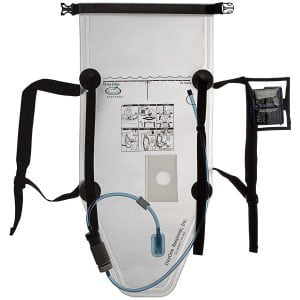
Agriculture
November 9, 2023
Implemented by
DayOne Response
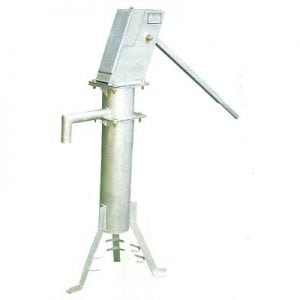
Agriculture
November 9, 2023
Implemented by
Mechanical Engineering Research & Development Organization (MERADO)

Agriculture
November 9, 2023
Implemented by
Mono Pumps
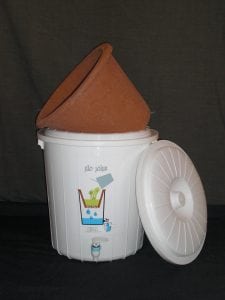
Agriculture
November 9, 2023
Implemented by
Tapp Global Design Inc
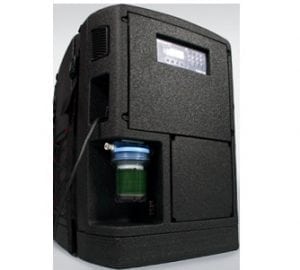
Agriculture
November 9, 2023
Implemented by
DEKA Research & Development
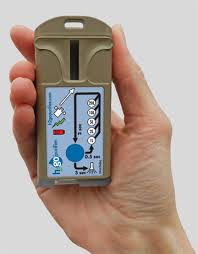
Agriculture
November 9, 2023
Implemented by
Aqua Research

Agriculture
November 9, 2023
Implemented by
YakuPura

Agriculture
November 9, 2023
Implemented by
Uzima

Agriculture
November 9, 2023
Implemented by
MSR
Have thoughts on how we can improve?
Give Us Feedback